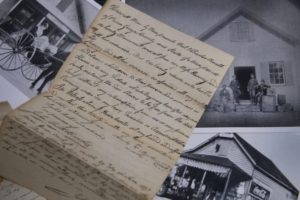
Paperwork documenting the manumission of enslaved Black Americans sat in Danny Dyer’s family safe for years. Photo by Linda Davidson/The Washington Post.
A general store owner from Maryland got quite the surprise when he finally untied the ribbon on a stack of antique documents his family had kept tucked in a safe for decades.
For years, Danny Dyer of Accokeek, Md., eye-balled the mysterious papers that read “Deed of Manumission” and listed the names of young men, women and children unknown to him. Unsure what “manumission” meant, Dyer looked it up and discovered he had a trove of freedom papers on his hands.
“Good God,” he thought.
The antique papers revealed the documented freeing of several enslaved African-Americans, many of whom were owned by some of Maryland’s first families years prior to the Civil War, The Washington Post reported. According to the documents, some of the enslaved workers were granted their freedom immediately while others’ manumissions didn’t take effect for several years. Some enslaved Blacks, like 35-year-old Aaron Jones, even saved up enough money to buy their freedom.
“The collection to me is absolutely mind-boggling,” said Laurie Verge, director of the Surratt House Museum in Clinton, Md., where Dyer lent the documents for study. The papers were put on display this month in the museum’s visitor center, according to The Washington Post. It’s the first time they’ve been put on public display.
One of deeds showed the emancipation of a 6-year-old named Pheby Ann Tyler, who was purchased by her father, John, of Washington, for $70. An enslaved woman and her children also were manumitted by her husband, who likely bought them just to free them.
Another manumission was ordered on Oct. 23, 1838, by a wealthy widow named Elizabeth W. Snowden, whose family was known for its opulent homes and hospitality. At one point, the Snowdens owned over 140 enslaved workers, The Washington Post reported. But documents from the Montpelier Mansion museum in South Laurel, Md., show he family’s number of slaves had dwindled to just 60 after Mrs. Snowden’s husband passed in 1831, leaving her with a plantation and 12 children to look after.
Fast forward seven years and the widow moved to manumit 30 enslaved African-Americans, asserting that “natural freedom is the right of all men,” according to Dyer’s old papers. Among the freed was a 43-year-old enslaved man named Henny, who was granted his freedom in 1839, and his wife, Hazel, 41, who was emancipated the following year. Their four children — Let, Nace, Ann Elizabeth and Sarah Jane — would be freed over the next 20 years.
Some might wonder why Mrs. Snowden chose to free Henny and Hazel but kept their young children enslaved for a period of time. Colleen Walter Puterbaugh, a research librarian at the museum, theorized that the widow may have kept them in bondage because manumission laws at the time discouraged the freeing of enslaved persons who were too young to take care of themselves — even though these children’s parents were alive and well.
The intention wasn’t to be kind, she explained, but to relieve society of the burden of looking after them.
“It may have been more for their safekeeping than for any monetary gain,” Puterbaugh told The Washington Post via email. “For the most part, the girls were freed when they reached the age of 22 and the boys when they reached 26 … this was [perhaps] considered the age of maturation at the time.”
Dyer, 74, said the deeds, which spanned the years 1781 to 1858, had for years been sitting amongst a heap of other documents in his family’s safe until he discovered what they were. He said the safe must’ve served as a kind of safe-deposit box and that the papers were put there in connection to his great-grandfather’s job as a local sheriff.
“I have no idea how long they’ve been in there,” he said. “My father didn’t seem to know. He said, ‘Well, they were just here. They’ve always been here.’ ”
After realizing the documents’ historic value and finding out that his son was dating the museum owner’s daughter, he handed the deeds over to Surratt House.
“I thought this might be a chance to find out a little bit more about these things,” Dyer said.


